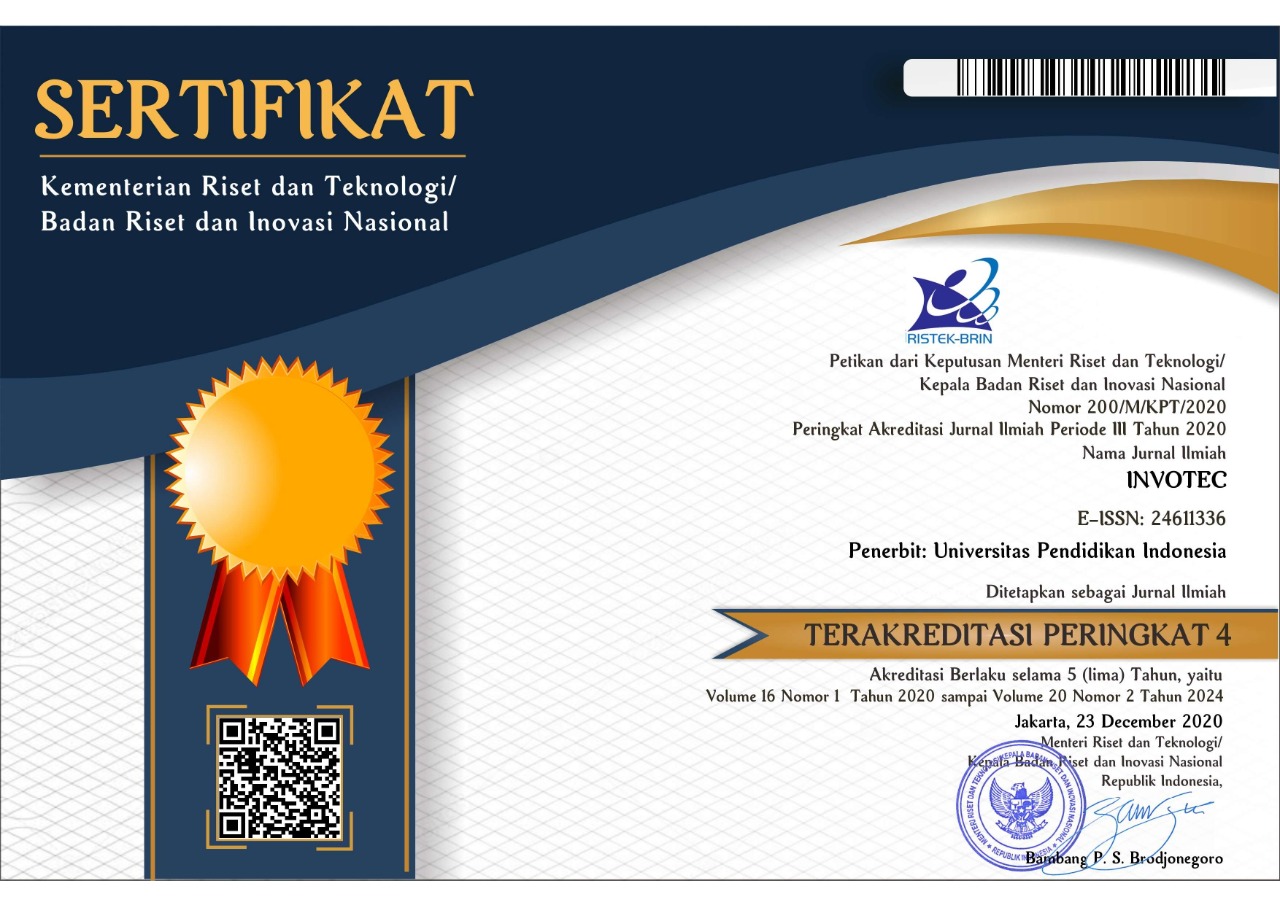Simulation-Based Digital Learning for Vocational Schools
Abstract
Students in vocational schools are generally faced with difficult material accompanied by learning facilities that are not optimal in attracting their attention. Simulation models can be done for students to practice appropriate skills in learning activities, the demands of the times in the era of the COVID-19 pandemic urge educators to produce digital simulation media that are suitable. Systematic Literature Review by analyzing documents and articles searched through an electronic database search engine use as method to be discussed. Simulation-based digital learning facilities require software in making simulation learning tools. Several simulators have been designed and applied to electrical learning in the automotive sector with the result that they can improve the quality of learning. Simulation-based digital technology provides practicality and completeness to user needs, especially those related to practical skills in vocational education. Meanwhile, there are still few simulators in the form of digital or software for learning electrical systems in the automotive sector.
Keywords
Full Text:
PDFReferences
Adedoyin, O. B., and Soykan, E. (2020). Covid-19 pandemic and online learning : the challenges and opportunities. Interactive Learning Environments, 1–13.
Amhag, L., Hellström, L., and Stigmar, M. (2019). Teacher Educators’ Use of Digital Tools and Needs for Digital Competence in Higher Education. Journal of Digital Learning in Teacher Education, 35(4), 203–220.
Bobka, P., Germann, T., Heyn, J. K., Gerbers, R., Dietrich, F., and Dröder, K. (2016). Simulation Platform to Investigate Safe Operation of Human-Robot Collaboration Systems. Procedia CIRP, 44, 187–192.
Cahyo, T. N. (2016). Software Development of Lighting System Trainer Simulation in Light Vehicle Electrical Maintenance Training Courses Light Vehicle Engineering SMK Negeri 7 Surabaya. Jurnal Pendidikan Teknik Mesin UNESA, 05, 64–71.
Cahyo, T. N., and Wailanduw. (2016). Pengembangan Software Simulasi Trainer Sistem Penerangan pada Mata Diklat Pemeliharaan Kelistrikan Kendaraan Ringan Teknik Kendaraan Ringan Smk Negeri 7 Surabaya. Jurnal Pendidikan Teknik Mesin UNESA, 05, 64–71.
Campos, N., Nogal, M., Caliz, C., and Juan, A. A. (2020). Simulation-based education involving online and on-campus models in different European universities. International Journal of Educational Technology in Higher Education, 17(1), 1-15.
Chae, S. (2016). Development and Application of the Simulator of Lighting Devices for Automotive Technical Education. Journal Of Ptactical Engineerin Education, 8(November), 91–94.
Chang, K. H., and Kuo, P. Y. (2018). An efficient simulation optimization method for the generalized redundancy allocation problem. European Journal of Operational Research, 265(3), 1094–1101.
Coman, C., Țîru, L. G., Meseșan-Schmitz, L., Stanciu, C., and Bularca, M. C. (2020). Online teaching and learning in higher education during the coronavirus pandemic: Students’ perspective. Sustainability (Switzerland), 12(24), 1–22.
Damasceno, E. F., Nardi, P. A., Silva, A. K. A., Junior, J. B. D., and Cardoso, A. (2017). 3D Virtual Simulation approach in Brazilian Vocational Education for Computers Network Adapted to Student Knowledge. IEEE Latin America Transactions, 15(10), 1917–1925.
Dobricki, M., Evi-Colombo, A., and Cattaneo, A. (2020). Situating vocational learning and teaching using digital technologies - A mapping review of current research literature. International Journal for Research in Vocational Education and Training, 7(3), 344–360.
Elbashti, M., Itamiya, T., Aswehlee, A., Sumita, Y., Ella, B., and Naveau, A. (2020). Augmented Reality for Interactive Visualization of 3D Maxillofacial Prosthetic Data. The International Journal of Prosthodontics, 33(6), 680–683.
Esteve-Mon, F. M., Cela-Ranilla, J. M., and Gisbert-Cervera, M. (2016). ETeach3D. Journal of Educational Computing Research, 54(6), 816–839.
Mayer, B. W., Dale, K. M., Fraccastoro, K. A., and Moss, G. (2011). Improving transfer of learning: relationship to methods of using business simulation. Simulation & Gaming, 42(1), 64-84.
Gegenfurtner, A., Quesada-pallarès, C., and Knogler, M. (2014). Digital simulation-based training : A meta-analysis. 45(6), 1097–1115.
Gönenç, İ. M., and Sezer, N. Y. (2019). Evaluation of the effectiveness of four different training techniques in the development of non-stress testing application skills: A randomised controlled trial. Nurse Education Today, 76(5), 118–124.
Helle, L., Nivala, M., Kronqvist, P., Gegenfurtner, A., Björk, P., and Säljö, R. (2011). Traditional microscopy instruction versus process- oriented virtual microscopy instruction : a naturalistic experiment with control group. 6(Suppl 1), 1–9.
Igwe, N. J., Kadiri, G. C., and Ekwueme, J. (2020). Impact of Information and Communication Technology on Acquiring the Literacy Skills outside the Classroom among Adults in Nsukka Urban. Journal of Language Teaching and Research, 11(6), 881.
De Jong, T., and Van Joolingen, W. R. (1998). Scientific Discovery Learning with Computer Simulations of Conceptual Domains. Review of Educational Research, 68(2), 179–201.
Keskitalo, T., and Ruokamo, H. (2021). Exploring learners’ emotions and emotional profiles in simulation-based medical education. Australasian Journal of Educational Technology, 37(1), 15-26.
Lin, J., and Zhang, Y. (2020). Research on the Application of Virtual Simulation Technology and Vocational Education Teaching. Journal of Physics: Conference Series, 1544(1), 012089.
Liu, Y. (2018). Design and development of computer assembly virtual simulation platform based on vocational education. 2017 3rd IEEE International Conference on Computer and Communications, ICCC 2017. Chengdu, China, 2474–2478.
Liu, Z. J., Tretyakova, N., Fedorov, V., and Kharakhordina, M. (2020). Digital literacy and digital didactics as the basis for new learning models development. International Journal of Emerging Technologies in Learning, 15(14), 4–18.
Makarova, I., Shubenkova, K., Antov, D., and Pashkevich, A. (2018). Digitalization of engineering education: From e-learning to smart education. In International Conference on Remote Engineering and Virtual Instrumentation. Duesseldorf, Germany, 32-41.
Makransky, G., Terkildsen, T. S., and Mayer, R. E. (2019). Adding immersive virtual reality to a science lab simulation causes more presence but less learning. Learning and Instruction, 60(November), 225–236.
Pardjono, P., Syauqi, K., Prasetya, W. A., and Baihaqi, S. (2020). Multimedia interactive learning of pictorial projection mechanical engineering skills in vocational high schools. Journal of Physics: Conference Series, 1700(1), 012009.
Peres, R. S., Guedes, M., Miranda, F., and Barata, J. (2021). Simulation-Based Data Augmentation for the Quality Inspection of Structural Adhesive with Deep Learning. IEEE Access, 9, 76532–76541.
Prieto, J. S., Torres, J. M. T., García, M. G., and García, G. G. (2020). Gender and digital teaching competence in dual vocational education and training. Education Sciences, 10(3), 84.
Puradimaja, H., Komaro, M., and Permana, T. (2019). Penerapan Simulator Electric Mirror Untuk Meningkatkan Kompetensi Dasar Memahami Sistem Kelistrikan Pengaman Dan Kelengkapan Tambahan Pada Peserta Didik Di Smkn. Journal of Mechanical Engineering Education, 5(2), 185.
Rogers, L. (2011). Developing simulations in multi-user virtual environments to enhance healthcare education _1057 608..615. 42(4), 608–615.
Samedov, M., Deryagin, A., Sahabiev, I., Pahuta, M., Rebenok, V., and Zakirova, N. (2020). Implementation of Digital Educational Technologies in the Field of Automotive Electronics in Higher Education Institution. International Journal of Engineering Research and Technology, 13(9), 2484–2490.
Santoso, Y. B., Permana, T., and Mubarok, I. (2019). Penggunaan Simulator Wiper Dan Washer Untuk Meningkatkan Pemahaman Kelistrikan Kendaraan Ringan Siswa Smk. Journal of Mechanical Engineering Education, 5(2), 267.
Shearer, R. L., Aldemir, T., Hitchcock, J., Resig, J., Driver, J., and Kohler, M. (2020). What Students Want: A Vision of a Future Online Learning Experience Grounded in Distance Education Theory. American Journal of Distance Education, 34(1), 36–52.
Shen, B., Chen, B., and Wang, Y. (2020). Virtual simulation of Lathe Machining Training Based on Unity3D. Journal of Physics: Conference Series, 1634(1), 012074.
Tafakur, T., and Solikin, M. (2018). Electronic Spark Advance Ignition System Simulator As Instructional Media for Assisting Electrical Practices on Automotive Field. VANOS Journal of Mechanical Engineering Education, 3(1), 43–50.
Wahlqvist, J., Ronchi, E., Gwynne, S. M. V., Kinateder, M., Rein, G., Mitchell, H., Bénichou, N., Ma, C., Kimball, A., and Kuligowski, E. (2021). The simulation of wildland-urban interface fire evacuation: The WUI-NITY platform. Safety Science, 136, 105145.
Winiasri, L., Nurlaela, L., and Sumbawati, M. S. (2020). Vocational Campus Readiness In The Disruption Era : A Case Study In Aviation Polytechnic of Surabaya. 2(6), 407–411.
DOI: https://doi.org/10.17509/invotec.v18i1.40572
Refbacks
Copyright (c) 2022 INVOTEC

This work is licensed under a Creative Commons Attribution-ShareAlike 4.0 International License.
This journal provides immediate open access to its content on the principle that making research freely available to the public supports a greater global exchange of knowledge.

This work is licensed under a Lisensi Creative Commons Atribusi-BerbagiSerupa 4.0 Internasional.


